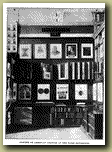In 1899, Librarian of Congress Herbert Putnam asked Library of Congress staff member Daniel A. P. Murray "to secure a copy of every book and pamphlet in existence, by a Negro Author, to be used in connection with the Exhibit of Negro Authorship at the Paris Exposition of 1900, and later placed in the Library of Congress." In consultation with African-American scholars across the country, Murray developed a list of 1,100 works. Five hundred of these were displayed in Paris.
 |
| Exhibit of American Negroes at the Paris Exposition. Photographer unknown. Photograph
undated, in Review of Reviews, vol. 22. |
Along with Murray's books and pamphlets, the display at the Paris Exposition consisted of photographs, charts, and works of art. There were portraits of African-American winners of the Congressional Medal of Honor, drawings of inventions patented by African-Americans, and photographs of the homes, schools, churches, and work places of black Americans. This unique display -- organized by African-American leader and scholar W. E. B. Du Bois -- won several medals, and much attention from visitors to the exposition. Du Bois called it "an honest, straightforward exhibit of a small nation of people, picturing their life and development without apology or gloss, and above all made by themselves."
After the Paris Exposition, the works collected by Daniel A. P. Murray and displayed in the exhibition were placed in the Library of Congress. At his death in 1925, Murray bequeathed his personal library of more than 1,400 volumes and pamphlets to the Library as well. The resulting collection of materials, many of them unique, provides a rich catalog of information on African-American life around the turn of the century. |


